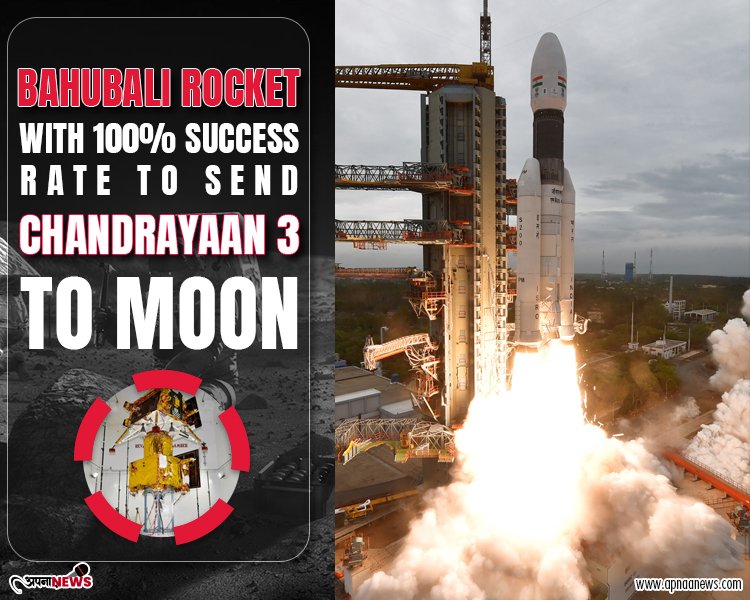Will the 'Bahubali Rocket' prove to be a complete ISRO success?
Find out if India's ambitious 'Bahubali Rocket' mission will be a complete success for ISRO. Get the latest updates and analysis on this groundbreaking mission

India's modified 'Bahubali' rocket is waiting at the Bay of Bengal coast in Andhra Pradesh's Sriharikota for the ready to launch India's Chandrayaan-3 satellite to the moon. The latest lunar exploration mission of the Indian Space Research Organisation is Chandrayaan-3.
Let us have a detailed look at the topic. Read the complete article and to know more about the ‘Bahubali Rocket’ and Chandrayaan-3.
Chandrayaan-3 Launch Date & Time
- The Chandrayaan-3 Mission aircraft is expected to launch from the Satish Dhawan Space Centre, which is located in Sriharikota, Andhra Pradesh, on Friday, July 14, 2023.
- It is an essential experiment for mastering gentle landings on a lunar planet, and if everything goes well, India's third moon voyage will start on the above-mentioned date at 02:30-02:35 Pm IST.
Why is this Mission so Important?
If Chandrayaan-3 is successful, we may witness the first Indian selfie from the surface of the moon depicting the nation's flag on the outermost layer of the moon.
Both Indian robots Vikram and Pragyaan contain imprints of India's tricolor. In the current age of social media, both have carefully positioned cameras.
Chandrayaan-3 Purpose
The aim of Chandrayaan-3 is to achieve a successful soft landing near the moon's south pole. India plans to analyze lunar soil, rove across the moon's surface, and record moonquakes.
According to Mr. S Somanath, Chairman of the ISRO:
“It also includes seven instruments for research, and if India achieves success, it would become the fourth country after Russia, the United States, and China to softly land on the moon”.
The SUV-sized satellite serves as a huge power module, propelling the Vikram Lander and Pragyaan Rover into the moon's orbit. If everything goes as planned, the landing on the moon could take place as early as August 23rd this year.
You can visit https://apnaanews.com/chandrayaan-3-all-you-need-to-know-about-indias-3rd-lunar-mission and get all the information about the Chandrayaan-3 Mission.
'Bahubali Rocket'
In the mission towards the moon, ISRO would send a Satellite together with a Lander and a Rover which in total weighed 3921 kilograms(Approximately) with the help of 'Bahubali Rocket'.
This satellite will cover over 4 lakh kilometer journey.
- LVM-3, frequently referred to as the 'Bahubali' of rockets, is a three-stage rocket powered by two solid-fuel boosters and one liquid-fuel core stage.
- The solid-fuel boosters give initial push, while the liquid-fuel main stage provides sustained thrust to send the rocket into orbit.
'Bahubali Rocket' Details
- The rocket has a propellant loading of 28 tonnes and is moved by two solid strap-on motors (S200), one liquid core stage (L110), and a high-thrust cryogenic upper stage (C25).
- The LVM-3 possesses a lift-off mass of 640 tonnes and can transport up to 4,000 kilograms of payload into (Geosynchronous Transfer Orbit) GTO.
- This will mark the rocket's sixth flight, which has a perfect success rate so far. As a result, expectations for an effective launch from India's space port are great.
'Bahubali Rocket' History
LVM-3 has already been used to launch a variety of satellites, including:
- The GSAT-19 communication satellite
- The Astrosat astronomy satellite
- The Chandrayaan-2 moon mission
It is also expected to be used to launch the Gaganyaan crewed mission, India's first space flight with humans.
How will the LVM-3 Operate?
- The rocket uses a staged combustion process, with liquid-fueled engines powering the main body and strap-on boosters.
- The spacecraft's core stage is powered by two Vikas engines, each providing 720 kN of thrust.
- In the meantime, two solid-fueled boosters give additional thrust during the launch's early phase.
- The upper stage on the LVM-3 is powered by the CE-20 engine, a cryogenic engine built in-house that delivers the thrust required to reach the ideal orbit.
Indian Space Research Organization (ISRO)
As reported by ISRO, the vehicle takes off due to the synchronized activation of both boosters, followed by the core stage (L110) activation roughly 113 seconds later.
Both S200 boosters fire for roughly 134 seconds before separating at 137 seconds.
After approximately 217 seconds after launch, the payload fairing housing the satellite is split at a height of 115 kilometers over the planet.
They say:
"The 43.5 m tall three-stage launch vehicle gives India full self-reliance in launching heavier communication satellites that weigh up to 4000 kg in GTO" .
Original Name of LVM-3
The rocket had been referred to as the GSLV-Mk III, but the Indian space agency renamed it as the LVM-3 after three successful missions.
Conclusion
The ‘Bahubali Rocket’ or LVM-3 is a heavy lift launch vehicle and it has been used to launch many different satellites. It is going to be a great achievement if the Chandrayaan-3 mission, which is going to launch on July 14th (Friday), is successful.
Stay connected to know more about the latest new updates and information. Don’t forget to bookmark our site to get the latest updates.






